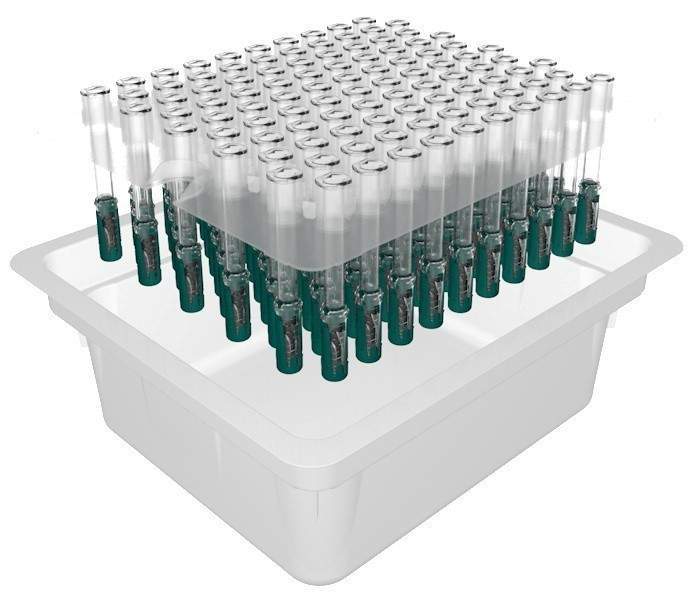Gerresheimer is offering a syringe, Gx InnoSafe, with an integrated passive safety system that avoids inadvertent needle stick injuries, prevents repeated use, and is designed with pharmaceutical companies’ production processes in mind as well as being optimized for simple and intuitive use by medical specialists.

Image: The needles are packaged in trays and standard tubs, including the safety lock, and sterilized with ethylene oxide gas. Photo: courtesy of Gerresheimer AG.
“For health care workers, handling used hypodermic needles is part of their day-to-day job. In some cases, this leads to serious diseases being transmitted. It is estimated that around one million needle stick injuries occur in Europe every year,” explains Maximilian Vogl, Product Manager Injection Devices, adding that in the worst case, it can lead to serious infections. There is also the risk of used syringes being used for a second time by accident.
Gx InnoSafe reliably protects against inadvertent needlestick injuries and prevents repeated use. Unlike many existing solutions, the needle shield mechanism is activated automatically and does not require any additional manipulation by the end user.
It is therefore known as a passive needle protection system. The processing of the Gx InnoSafe syringes, which can be carried out without any major changes to existing lines in a nested state, is just as beneficial to pharmacists. This eliminates the need for an additional step to assemble the safety system, as is currently standard on the market.
The user wants a safety system that does not change the familiar injection procedure, that is intuitive and ergonomic to handle, and that requires no additional manual activation to secure the cannula before it is disposed of. As part of the manufacturing process, the Gx InnoSafe safety system is installed on Gx RTF glass syringes in the clean room like a standard needle shield.
The syringe body is completely visible so that the presence of the active ingredient, its purity, and its administration can be observed and monitored ideally. The injection itself is also administered as usual. After removing the ergonomic sealing cap with an integrated, flexible needle shield, the syringe is placed on the injection site, the cannula is inserted into the tissue to be administered, and the active ingredient is injected as with a common syringe. The safety system cannot be activated inadvertently because the mechanism is not preloaded before the injection.
The system is only activated when the cannula is inserted and it automatically ensures that the safety mechanism is permanently locked when the syringe is removed from the injection site. This guarantees that the cannula is reliably covered and the syringe cannot be reused.
Gx InnoSafe provides advantages for pharmaceutical companies in the filling process of ready-to-fill syringes. The safety system is installed during the RTF process entirely automatically and fully checked for any punctures and positioning with a visual inspection.
The syringes are then packaged into trays of 100 (nests) and tubs, including the safety system, and are then sealed and sterilized with ethylene oxide gas. They can be processed on existing filling lines without any additional preparation or assembly steps.
The design of the safety mechanism avoids inadvertent activation during filling, packaging, and transport. The flexible needle shield part is available in all standard market elastomers for pharmaceutical applications. With the introduction of the new product line, Gx InnoSafe is available for the 1.0 ml long RTF glass syringe with ½ “cannula. Further needle variants will follow.
Gerresheimer will showcase its product and services from October 9-11 at CPhI Worldwide in Madrid, IFEMA, Hall 4, booth C30.
Gx® and RTF® are registered trademarks of the Gerresheimer Group. InnoSafe is a pending trademark of the Gerresheimer Group.
